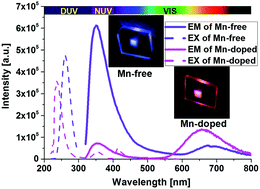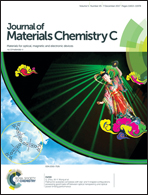Bane to boon: intrinsic defect sensitized photoluminescence from Mn2+ or rare-earth ion doped fluorosilicate photonic glasses†
Abstract
Defects present ubiquitously in glasses exert a strong influence on the optical qualities and performances of glass, a phenomenon that has not been well studied to date. In this paper, novel fluorosilicate (FS) photonic glasses based on SiO2–KF–ZnF2 are reported which exhibit an intense near-ultraviolet (NUV) photoluminescence (PL) at 350 nm when excited by deep-ultraviolet (DUV) light centered at 260 nm. That the strong NUV PL, with an internal quantum efficiency as high as 85%, is a unique feature of the studied FS glasses has been confirmed by a thorough comparison of a wide range of glasses including silica, silicate, borate, phosphate, germanate, tellurite, fluorosilicate, fluoroborate, fluorogermanate and fluoride glasses. The NUV emission is attributed to intrinsic defects in the FS glasses, and the possible origin of the intrinsic defects is suggested. The effects of intrinsic-defect-sensitized PL of Mn2+ and rare-earth ion doped FS glasses are illustrated for the first time, and the sensitization mechanism is discussed. Our results demonstrate that defects, when properly controlled and understood, can be an enriching factor endowing the photonic glasses with a number of new and advantageous functions.



 Please wait while we load your content...
Please wait while we load your content...